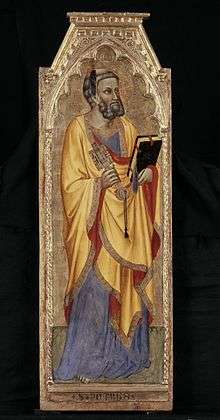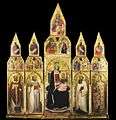Cecco di Pietro

Cecco di Pietro was an Italian painter of the Pisan School. While his date of birth cannot be confirmed, there is some mention of a Cecco Pierri working with the painter Paolo di Lazzarino in 1350. If this was a reference to di Pietro, then his date of birth can be placed around 1330.[1]
He was active starting from around 1370 and died sometime before 1402. Cecco is seen as an important figure in Trecento art because of his development of a style that incorporated elements of Pisan painting along with those of the Sienese School.
Life and work
Early documents indicate that some of Cecco di Pietro's first work as an artist was restoring frescoes. He is first mentioned in notices from around 1370 as having worked at the Campo Santo with five other painters working on restoring frescoes in the area. He is next mentioned in notices from 1372 concerning the restoration of the Story of Job fresco in the Campo Santo with Francesco Volterra.[2] Records regarding his pay from the time show that it was a small sum of money when compared with other artists of the day, indicating that he was still inexperienced and learning the craft of the Pisan school from Volterra.
Following the restoration of the Story of Job, there is another notice of Cecco di Pietro being hired in 1379 to restore the Inferno from a trio of frescoes by Buonamico Buffalmacco which were also located in the Campo Santo and were apparently damaged by some untrained apprentices in a previous restoration attempt. Of the restoration of the Inferno, most scholars only attribute the 2nd circle of Hell and two figures to the side of the Devil as the portions restored by Cecco, with the other restoration work carried out by a separate unknown artist.
Cecco continued to receive a number of local commissions painting many altarpieces. One such altarpiece is the Polyptych of Agnano, executed between 1386–1395 for the church and convent at Agnano, and is considered one of Cecco’s most important pieces. He continued to work in the fresco style until his death around 1402[3]
Style
During his career Cecco worked in themes common to other artists of the Trecento period. Much of the artwork produced by Cecco was of the Virgin and Child such as The Virgin and Child With Donors in 1386, which was part of a polyptych that has since been separated and its various pieces are located in different museums around the world. In documents from 1380 we see that Cecco was referred to as anziano or “elder” in Italian. This classifies him as a representative of the “San Simoncino di Porta” parish that he belonged to in Pisa.
Initial evaluations by early art historians looked on Cecco di Pietro's work as not being historically or technically significant.[4] Additionally, some early art historians did not critically consider the Pisan School as a whole.[5] Later Cecco's work has been reevaluated, and is now seen as one of the Pisan masters with his own unique style. His style evolved over his career, starting first as an example of the Pisan School of painting and eventually developing into a hybrid of Sienese and Pisan styles.[1] Cecco's greatest influence from the Pisan school was in his use of punches, a decoration trend where the artist would punch shapes and patterns out of metal to be incorporated in the painting that was very popular in Tuscany during the Trecento.[6][7]
His earlier work such as The Madonna and Child with Donors is more naturalistic when compared with his later works, where his figures take on a more elongated and ethereal appearance similar to the Sienese style at the time. This is seen most prominently in the depiction of the head of the child.[8] Another work that clearly displays this shift towards more ethereal figures is the recently restored Virgin and Child Playing with a Gold Finch.. In this painting the Madonna's face and neck have taken on a longer more drawn appearance, and the fingers of the Madonna are long and slender.
It is unknown what exactly brought about this shift in Cecco's style but there is some work that suggests that Sienese painter Luca di Tommè may have been an influence. Whether through direct mentorship or Cecco's admiration of his work, there are many similarities between works of Tommè and later works of Cecco. These similarities can be seen between Cecco's Polpytch of the Crucifixion from 1386 and a similar scene by di Tomme from 1366.[2] Cecco created many works in this hybrid style which presents an example into the shifting styles of painters at the start of the Italian Renaissance.
List of works
- Crucifixion between the Virgin and Saints, Academy, Pisa
- Virgin and Child (1370), private collection Rimedio, Pisa
- Virgin and Child (1380), private collection Tezi, Pisa
- Virgin and Child with Donors (1386), Portland Art Museum
- Polyptych of Agnano (1386–1395), Palazzo Blu, Pisa[9]
- Virgin and Child with Finch (v.1371), Statens Museum for Kunst, Copenaghue
- Saint Jerome in His Studio (v.1370), North Carolina Museum of Art, Raleigh
- The Baptism of Christ (compartment predella)
- Blessed Gerardo da Valenza, Tempera and gold on wood 34 x 16 cm
- St. Benedict, Musée du Petit Palais, Avignon
- Saint Barthelemy (1386)
- Saint Nicolas (1386)
- St. Pierre (1386)
- St. John the Baptist (1386)
Frescoes
- Campo Santo, Pisa
- San Martino in Kinzica, Pisa
Gallery of selected works
 Cecco di Pietro, Madonna and Child, Copenhagen Statens Museum for Kunst
Cecco di Pietro, Madonna and Child, Copenhagen Statens Museum for Kunst Cecco di Pietro, Madonna with Child 1386 Portland Art Museum
Cecco di Pietro, Madonna with Child 1386 Portland Art Museum Cecco di Pietro. Polyptych from Agnano. 1386-95.
Cecco di Pietro. Polyptych from Agnano. 1386-95.
References
- 1 2 “Cecco Di Pietro in Dizionario Biografico – Treccani”, n.d. http://www.treccani.it/enciclopedia/cecco-di-pietro_(Dizionario-Biografico)/
- 1 2 van Marle, R., and C. van Marle. The Development of the Italian Schools of Painting. The Development of the Italian Schools of Painting. M. Nijhoff, n.d. https://books.google.com/books?id=nMExAAAAMAAJ.
- ↑ Multiple Sources from Crowe and Shapley as well as Galerie G.Sarti “Cecco Di Pietro, Gallery Giovanni Sarti”, n.d. http://www.sarti-gallery.com/site/paintings/artists/ceccodipietro/index.html?viewartist=59.
- ↑ Sirén, Osvald. “Trecento Pictures in American Collections-V.” The Burlington Magazine for Connoisseurs 15, no. 75 (June 1, 1909): 197–196.
- ↑ Crowe, Joseph Archer. A History of Painting in Italy Umbria, Florence and Siena, from the 2nd to the 16th Century. London England: J. Murray, 1908.
- ↑ Frinta, Mojmír S. “An Investigation of the Punched Decoration of Mediaeval Italian and Non-Italian Panel Paintings” The Art Bulletin Vol. 47, No. 2 (Jun., 1965), pp. 261-265 http://www.jstor.org/stable/3048260
- ↑ Frinta, Mojmír S. “A Seemingly Florentine Yet Not Really Florentine Altar-Piece.” The Burlington Magazine 117, no. 869 (1975): 527–535.
- ↑ Crowe, Joseph Archer. A History of Painting in Italy: Umbria, Florence and Siena, from the 2nd to the 16th Century. London, England: J. Murray, 1908. p. 164
- ↑ "Polittico di Agnano, tempera su tavola" (in Italian). Fondazione Palazzo Blu. Retrieved 25 February 2016.
Bibliography
- Anon. “Cecco Di Pietro in Dizionario Biografico – Treccani.”
- “Cecco Di Pietro, Gallery Giovanni Sarti.”
- “Nuove Proposte Per Il Polittico Di Agnano Di Cecco Di Pietro.”
- Ault, Katharine. 1991. “A Predella Panel from Cecco Di Pietro’s Agnano Altar-Piece.” The Burlington Magazine 133 (1064) (November 1): 766–770.
- Bryan, Michael. 1903. Bryan’s Dictionary of Painters and Engravers. London England: G. Bell and Sons.
- C. Gardner von Teuffel. 1979. “The Buttressed Altarpiece: A Forgotten Aspect of Tuscan Fourteenth Century Altarpiece Design.” Jahrbuch Der Berliner Museen 21 (January 1): 21–65.
- Champlin, John Denison, and Charles Callahan Perkins. 1913. Cyclopedia of Painters and Paintings. C. Scribner’s Sons.
- Crowe, Joseph Archer. 1908. A History of Painting in Italy Umbria, Florence and Siena, from the 2nd to the 16th Century. London England: J. Murray.
- Crowe, Joseph Archer, and Giovanni Battista Cavalcaselle. 1908. A New History of Painting in Italy : from the II to the XVI Century. London England: Dent.
- Frinta, Mojmír S. 1975. “A Seemingly Florentine Yet Not Really Florentine Altar-Piece.” The Burlington Magazine 117 (869): 527–535.
- van Marle, R., and C. van Marle. The Development of the Italian Schools of Painting. The Development of the Italian Schools of Painting. M. Nijhoff. https://books.google.com/books?id=nMExAAAAMAAJ.
- Shapley, Fern Rusk., and Samuel H. Kress Foundation. 1966. Paintings from the Samuel H. Kress Collection: Italian Schools. Complete Catalogue of the Samuel H. Kress Collection. London, New York: Published by Phaidon P. for the Samuel H. Kress Foundation; distributors in U. S.: F. A. Praeger. http://catalog.hathitrust.org/Record/000573122.
- Sirén, Osvald. 1909. “Trecento Pictures in American Collections-V.” The Burlington Magazine for Connoisseurs 15 (75) (June 1): 197–196.
- Vertova, Luisa. 1956. “Early Italian Paintings at the Orangerie.” The Burlington Magazine 98 (642): 309–314.
External links
| Wikimedia Commons has media related to Cecco di Pietro. |